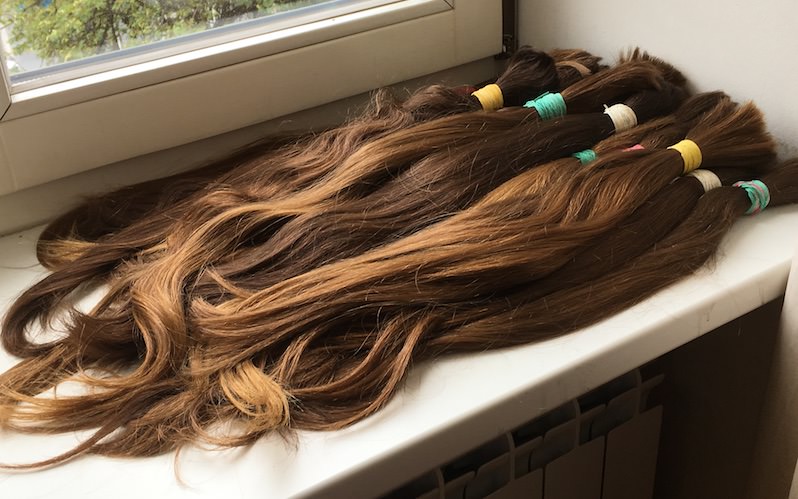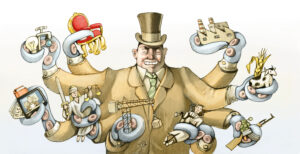The Dirty Secrets of the Global Hair Trade
Supplying the rich with hair from poor women and children is not “meeting a need” but creating a demand. Human-hair brokers draw their supplies from economically disadvantaged women around the world. (Julie Bindel)
Human-hair brokers draw their supplies from economically disadvantaged women around the world. (Julie Bindel)
Ukraine is known for being the largest country in Europe, having the deepest underground metro station and being host to the very first university in Eastern Europe. It is also becoming increasingly popular with hair traders—the men (usually) who scour villages and impoverished urban areas seeking girls and women who need fast cash.
I am in Ukraine, which is classed as a developing country by the World Trade Organization, to investigate the lucrative trade in human hair. I’m intrigued with why this part of the world has become so notorious for it.
“Rich white women such as Victoria Beckham and Britney Spears wear [hair extensions],” says Artmen, my driver, who grew up in Kiev and witnessed girls in his neighborhood with long hair one day and shorn hair the next. “You see the advertisements everywhere you go. I suppose it is a good idea when there is nothing left to sell.”
On average, Ukrainian women earn less than $150 a month, and they are vulnerable to exploitation by capitalists who cash in on desperation. (It is no surprise that another booming industry in Ukraine is “mail order brides.”) “We buy hair for the highest price,” reads an advertisement on a lamppost on a street of run-down apartment buildings on the outskirts of Kiev. “The haircut is for free.”
Hair brokers scour villages, towns and cities, searching for long-haired women and girls to target with offers of cash. More than 20 percent of households in Ukraine are headed by single mothers. Overall, 60 percent of Ukrainian citizens live below the poverty line. It is a perfect place for profiteers to hunt their prey.
Much of the global hair trade, thriving in countries such as China, India and Peru, relies on communities where long, natural hair is an integral component of feminized beauty, and where the girls and women are poor enough to take the drastic step of selling it.
The hair trade involves the creation of hair extensions for well-off Western women who want the illusion of having long, flowing locks. Once the brokers have their hands on the product, the buyers take over, selling the hair to the highest bidder, including salon owners and trade shows. I visited one salon in London that deals with human hair and charges clients up to $500 for 20-inch extensions. The salon paid less than $100 for the product. I was told that clients were not interested in the original owner of the hair—only that the product was untreated and clean. When I explained that I was critical of the industry and considered it exploitation to farm hair this way, the manager refused to let me name the salon.
A man for whom I will use the fictitious name Vihaan has a business selling Ukrainian hair that he markets as “Russian” to customers based mainly in the United States. He says the hair business thrives in Ukraine for the simple reason that its women and girls are impoverished.
I contacted Vihaan by email, claiming to be the owner of a hair salon in London. I asked if we could meet when he was next in Kiev and he readily agreed, giving me the address of his rented apartment in the center of the city.
Well-dressed and brimming with confidence, Vihaan led me through his sprawling apartment, pointing to a shelf near a large window where several ponytails were on display. I felt uncomfortable seeing the disconnected hair. As I picked up one of the ponytails, feeling its silkiness, I wondered about the girl or woman it had come from. “It is virgin hair,” Vihaan said proudly. “It has never been dyed, permed or treated with any chemicals, ever.”
I asked if that meant it had belonged to a child. I added that my customers have “a lot of money” but are socially conscious and would not want to collude with exploitative practices. Vihaan appeared nonchalant, shrugging slightly. “It’s all very consensual,” he said.
I was offered the hair at “a good price” of $2,700 a kilo [1 kilo is equivalent to 2.2 pounds], and a further discount if I took the 2.5 kilos on display. “I charge double for the blonds,” he said, “so if you only picked out the light ones I would have to charge you more.”
He told me there was no need to worry about declaring the hairpieces going through customs.
Telling him I needed time to think, I left, sensing a slight animosity from him. Perhaps he expected me to hand over the cash there and then. Later that day I emailed him, asking for reassurance that there was no exploitation involved in the trade.“I do understand your concerns,” he replied. “It’s a commercial transaction between hair gatherers and the girls who want to sell their hair for some monies. It’s usually hair that has been kept in store (it’s a Ukrainian tradition) after a teenage haircut and then handed over. There’s no coercion involved. Usually they have signs all over the small towns and cities of the Ukraine.”
But I spoke to women who had sold their hair as children or young women, and they had a different story to tell.
Julia Stets is a freelance wig maker and hairstylist working from her apartment in suburban Kiev. Stets at one time bought hair from China but in recent years has switched to synthetic hair, which she tells me is of high quality and “very authentic” looking. I asked to interview Stets about her experience working with human hair, but soon she was recounting a story from her childhood in the rural western part of the city.
“I faced hair traders in my childhood,” Stets said. “In 1993, when I was 13, the broker gave me $7 for my hair, and it was a painful experience.
“He had promised me $50 but told me my hair was bad quality, and less than he had thought, despite my hair being thick and very long,” she said. “There were a lot of girls they tricked like that—it was like a fraud.”
The broker did not ask Stets’ parents for permission before cutting her hair, and she said he treated her “like garbage. He saw I needed money, and just exploited me.”
“This happens in rural China, just the same,” said Stets, who, on discovering this decided to stop working with human hair. “There are young women who want to find some money to study or get their own life—and here comes the businessman, so they sell what they can of themselves.”
I asked Stets if, when she used to buy human hair, she thought about the women it came from.
“Always,” she replied. “I imagined the girls and [wondered] if they felt like me when it happened, and if they also had money stolen from them by the brokers.”
At a hair studio in Kiev, I met Natali, the proprietor, an intense young woman who was clearly an astute entrepreneur. The studio specializes in hair extensions, and Natali noted that human hair has become an extremely popular product in recent years. The hair is sourced from western Ukraine because it is much cheaper, because the girls are desperate to earn money, Natali explained.
Do her clients ever wonder where the hair comes from? I asked.
“No—they don’t bother themselves with that.”
Do the girls ever get upset at losing their hair?
“No, but there was one case when a girl [had] cut her hair in another salon and came to me and asked me to extend her hair with her own hair because she just changed her mind.”
Is hair a human waste product or a body part? We don’t need hair on our heads except for vanity or perhaps to keep us warm, but hair has a powerful cultural significance. In conservative cultures, women use their hair to establish a group identity. It is deeply connected to the identities of females in many societies.
In the Puno region of Peru, Andrea, then 12 years old, with shining, jet-black hair almost down to her waist, stood shaking while a man took a tape measure from around his neck. He declared that her ponytail was 22 inches and worth $100. Andrea said nothing while the hair trader hacked off her hair at the nape of her neck, fastening a rubber band around the mane before carefully placing it in his large Hessian bag. “Your hair is filthy,” said the trader. “I’m going to have to get it treated. But you can have $30 for it.”
I contacted Andrea, now a young adult, by Skype.
“I now know that the trader was supposed to seek permission from my parents before he could take my hair,” Andrea said. “But he stopped me on my way home from school, and promised that he would only take a bit of my hair, and that we would get lots of money to go on holiday if he did this. My parents beat me when they found what I had done, and accused me of spending the rest of the money, when in fact he had only given me a fraction of what he had promised.”
As with any industry built on the exploitation of poor, disenfranchised women and girls, organized crime is sometimes involved.
In 2013, police in the Venezuelan city of Maracaibo hunted a gang of thieves who were targeting woman for their long hair. The “piranha gang” hacked women’s hair right off their heads. Sometimes they had guns.In 2006, The Guardian reported that in India, men were forcing their wives and children to sell their hair and hair brokers were holding children down and cutting off their hair.
Last year in East Jerusalem, I spoke with a Palestinian woman who told me she had had her hair “stolen” by a gang of young men when she was 8 years old. She assumed that her hair had gone to make wigs for Haredi (an orthodox Jewish sect) women, a highly profitable business in parts of the Middle East.
The majority of “sheitel”—or wigs—that married women from this sect are required to cover their own hair with are made in China. Most of the hair used is imported from India, which is much finer than Chinese hair and far more readily available than the European variety. These wigs cost around $1,825 each and require 150,000 hand-tied knots to make.
In India, which boasts a huge hair trade, factory workers as young as 12 spend their days sorting, combing and cleaning hair collected from villagers, barber shops and the floors of temples. The human-hair trade in India is estimated to be worth $395 million per year. In recent years, human hair has become a sought-after commodity in Africa.
Human-hair extensions are the new Botox, but the key difference is that Botox is not a product of a human body. Hair is often integral to the identity of girls and women who live under patriarchal rule, and many are punished and stigmatized if they deviate from the norm of long hair.
As with any business built on the commodification of the human body, supplying human hair from poor women and children to their rich Western counterparts is not “meeting a need” but creating a demand.
On my return to the U.K., I emailed Vihaan to tell him that I was an undercover journalist. “Even bad press is good press,” he responded, asking me to mention the name of his business in my article.
During our meeting in Kiev, Vihaan told me that selling hair was a “commercial and a normal transaction: Somebody has hair and they sell it.” I have heard this same argument used to justify prostitution, womb-rental and the buying and selling of breast milk. In order to create a marketplace out of a human body, it is first necessary to dehumanize it. The hair trade may appear to be fairly benign on the surface, but it exists because sometimes the female body is afforded worth only when it can be turned into profit.
Your support matters…Independent journalism is under threat and overshadowed by heavily funded mainstream media.
You can help level the playing field. Become a member.
Your tax-deductible contribution keeps us digging beneath the headlines to give you thought-provoking, investigative reporting and analysis that unearths what's really happening- without compromise.
Give today to support our courageous, independent journalists.






You need to be a supporter to comment.
There are currently no responses to this article.
Be the first to respond.